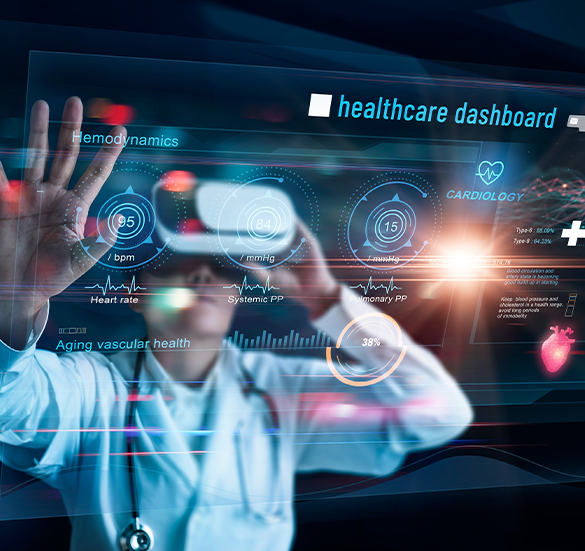This website uses cookies so that we can provide you with the best user experience possible. Cookie information is stored in your browser and performs functions such as recognising you when you return to our website and helping our team to understand which sections of the website you find most interesting and useful.

Related Category Blog
Archives by Month:
Revolutionizing Healthcare in India with AR, VR and XR

The healthcare industry in India has been grappling with several challenges such as inadequate infrastructure, shortage of medical personnel, and low doctor-patient ratios. India has only one doctor for every 1,457 people, which is far below the global average of one doctor for every 600 people. However, the advent of cutting-edge technologies such as augmented reality (AR), virtual reality (VR), and extended reality (XR) has immense potential to change the game for healthcare providers and patients alike. In this article, we will explore how AR, VR, and XR are transforming the healthcare landscape in India and the impact they are having on patients, doctors, and the entire healthcare ecosystem.
Healthcare challenges in India
India faces several healthcare challenges that are unique to the country. For instance, the lack of adequate healthcare infrastructure in rural areas makes it difficult for patients to access medical facilities. Moreover, the shortage of medical personnel, especially in critical care and emergency medicine, poses a significant challenge to the healthcare system. The high cost of healthcare services and medicines also makes it difficult for patients from low-income households to access quality healthcare. Additionally, the prevalence of lifestyle diseases such as diabetes, hypertension, and obesity are on the rise, putting a strain on the healthcare system.
AR, VR, and Extended Reality in healthcare
AR, VR, and XR are immersive technologies that have been gaining traction in the healthcare industry in recent years. AR involves overlaying digital information onto the real world, while VR creates a completely artificial environment that simulates a real-life situation. XR is a catch-all term that encompasses both AR and VR, as well as other immersive technologies such as mixed reality (MR) and haptic feedback. These technologies are being used in various applications, from medical education and training to patient care and treatment.
Benefits of AR, VR, and Extended Reality in healthcare
The use of AR, VR, and XR in healthcare has several benefits. For instance, AR can help doctors visualize complex medical procedures and anatomy in real-time, making it easier for them to diagnose and treat patients. VR is being used to treat mental health issues such as anxiety disorders and phobias, providing patients with a safe and controlled environment to confront their fears. XR is being leveraged to create immersive training simulations for medical professionals, enabling them to gain hands-on experience in a safe and controlled environment. These technologies are also making healthcare more accessible and affordable, especially for patients in remote and underserved areas.
Innovative use cases of AR, VR, and Extended Reality in healthcare in India
Several healthcare providers and startups in India are leveraging AR, VR, and XR to create innovative solutions that are transforming the healthcare landscape. For instance, a Bangalore-based startup called Augnito is using AR to create a real-time transcription service that converts doctor-patient conversations into text, making it easier for doctors to document patient information. Another startup called Tesseract Imaging is using AR to create a portable ultrasound device that can be used in remote and underserved areas.
Challenges in implementing AR, VR, and Extended Reality in healthcare in India
While the use of AR, VR, and XR in healthcare has several benefits, there are also several challenges that need to be addressed. For instance, the high cost of these technologies can be a barrier to adoption, especially for healthcare providers in resource-constrained settings. Additionally, there are concerns around data privacy and security, as these technologies involve the use of sensitive patient information. Moreover, the lack of regulatory frameworks and standards can make it difficult for healthcare providers to adopt these technologies.
Future of AR, VR, and Extended Reality in healthcare in India
The future of AR, VR, and XR in healthcare in India looks promising, with several startups and healthcare providers exploring innovative use cases for these technologies. As the healthcare industry continues to evolve, the adoption of these technologies is expected to increase, making healthcare more accessible, affordable, and personalized. However, there is a need for greater collaboration between healthcare providers, startups, and policymakers to address the challenges and ensure the responsible use of these technologies.
The way forward
The use of AR, VR, and XR in healthcare is revolutionizing the way healthcare is delivered and received in India. These technologies are enabling healthcare providers to overcome several challenges and provide better care to patients. However, there are also several challenges that need to be addressed, such as the high cost of these technologies and concerns around data privacy and security. Going forward, there is a need for greater collaboration and innovation to ensure that these technologies are used responsibly and for the benefit of all stakeholders in the healthcare ecosystem. With the right approach, we can harness the power of AR, VR, and XR to build a healthier and more equitable future for all.





